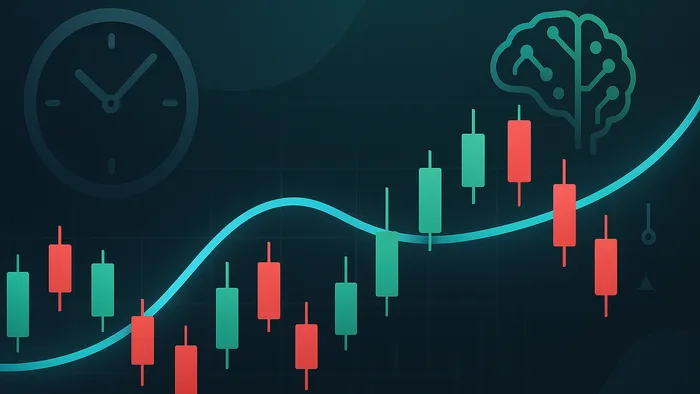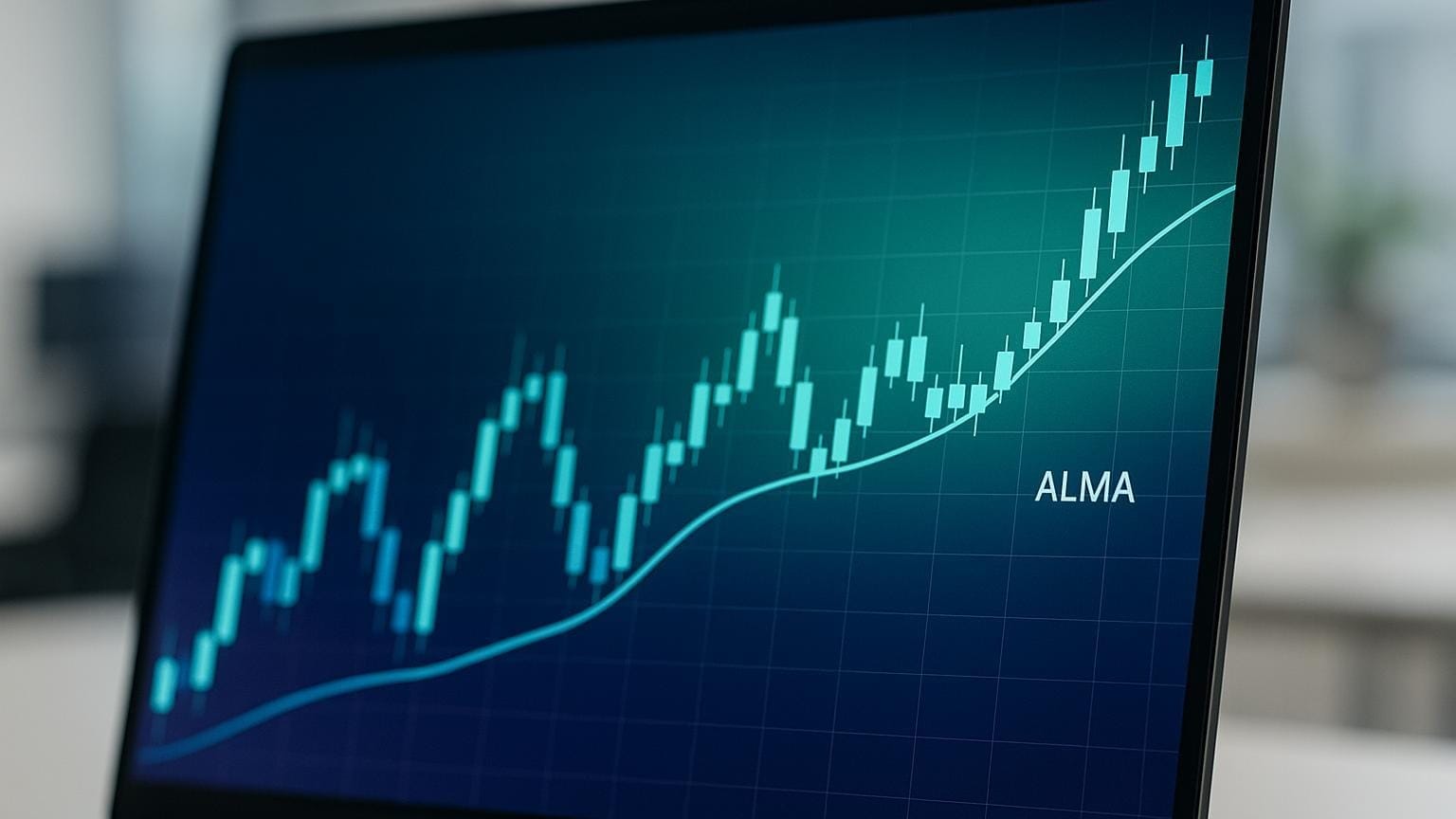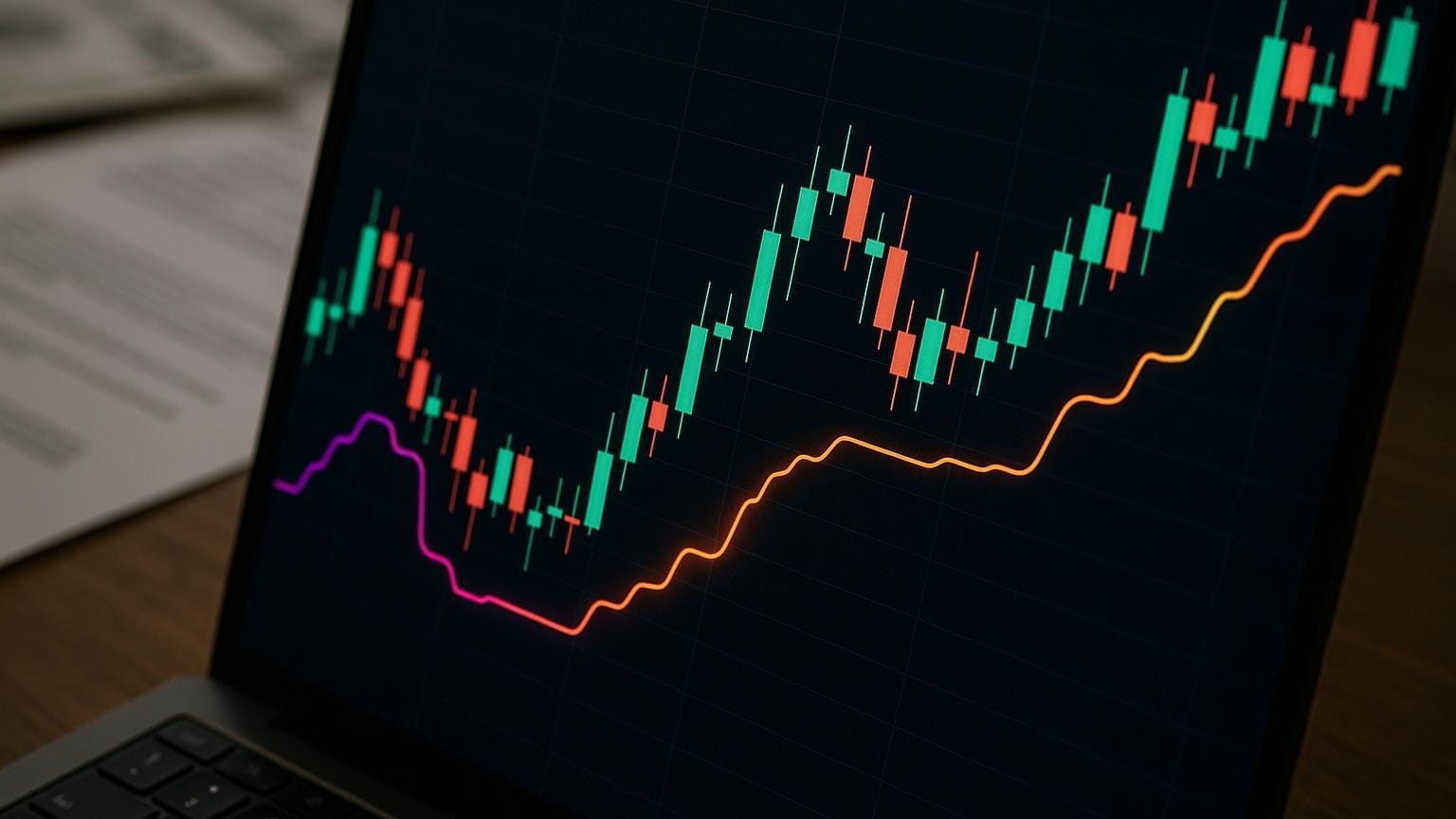Explore the Time-Weighted Average Price (TWAP) indicator, a crucial trading tool for executing large orders while minimizing market disruption.
The Time-Weighted Average Price (TWAP) is a straightforward trading approach designed to calculate the average price of a security over a set time period, without considering trading volume. It’s especially useful for traders looking to execute large orders without disrupting market prices.
Key Points
- Formula: TWAP averages prices over equal time intervals: TWAP = (P₁ + P₂ + P₃ + ... + Pₙ) / n.
- Purpose: Helps traders execute large trades by splitting them into smaller, evenly timed chunks (see the AI Backtesting Assistant overview for strategic context).
- Why It’s Useful:
- Reduces price impact for large trades.
- Works well in both low-liquidity markets (e.g., small-cap stocks) and volatile markets (e.g., cryptocurrencies).
- Provides a consistent benchmark to evaluate trade execution.
TWAP vs. VWAP
- TWAP: Focuses on time, ignoring volume.
- VWAP: Weights prices based on trading volume, making it sensitive to large orders and liquidity variations. If you need a VWAP overview on TradingView, see LuxAlgo’s VWAP resources. For a general definition, see this VWAP explainer.
Practical Applications
- Institutional Traders: Use TWAP to handle large block orders, avoiding sharp price swings.
- Retail Traders: Use it for strategies like dollar-cost averaging (dollar-cost averaging guide) or intraday trading.
Pros and Cons
- Advantages:
- Reduces market impact.
- Offers predictable execution timing.
- Simplifies performance evaluation.
- Drawbacks:
- May miss ideal prices in trending markets.
- Less flexible in fast-changing conditions.
TWAP is widely used in U.S. markets, offering a reliable method for stable trade execution in equities, cryptocurrencies, and low-liquidity assets. LuxAlgo provides tools on TradingView that complement TWAP with real-time calculations, customization options, and AI-driven strategy optimization (AI Backtesting platform).
How TWAP Works: Calculation and Display
TWAP Formula Explained
The calculation of Time-Weighted Average Price (TWAP) is a simple mathematical process that averages prices over equal time intervals. The formula looks like this:
TWAP = (P₁ + P₂ + P₃ + ... + Pₙ) / n
Here, P represents the price at each time interval, and n is the total number of intervals. Unlike volume-weighted methods, TWAP gives equal weight to all price points, regardless of trading volume.
For instance, let’s calculate a 4-hour TWAP using 15-minute intervals. This would involve 16 price points, each equally weighted. Imagine Apple (AAPL) trades at $150.25, $150.50, $150.75, and $151.00 during the first hour. These four prices contribute equally to the average, without factoring in whether 1,000 or 100,000 shares traded at each price.
While platforms handle these calculations automatically, understanding the process can improve your timing and execution. Because TWAP focuses on time rather than volume, it treats periods of low and high activity equally, offering a benchmark that reflects price trends instead of trading intensity. Up next, we’ll explore how the choice of time intervals impacts TWAP accuracy. If you want to explore related price action topics, see Price Action Concepts in the Library.
Time Interval Effects on TWAP
Once you understand the formula, it’s important to consider how the length of time intervals impacts the results. The interval you choose directly influences TWAP’s precision and can shape your trading strategy. Shorter intervals, such as 1 or 5 minutes, provide more detailed data but may be skewed by temporary price spikes or gaps. On the other hand, longer intervals, like 30 minutes or an hour, smooth out short-term fluctuations but might overlook key price movements.
For day traders, 15-minute intervals often strike the right balance. They capture significant price action without being overly sensitive to minute-by-minute noise. In U.S. equity markets, which operate from 9:30 AM to 4:00 PM ET (a 6.5-hour session), this approach results in 26 data points for the TWAP calculation (NYSE trading hours).
Institutional traders managing larger positions tend to use longer timeframes. For example, a pension fund executing a $100 million trade might calculate TWAP over several days, using daily price points to track broader market trends and avoid intraday volatility.
The chosen interval also affects execution strategy. If you’re using TWAP to guide a 2-hour trade with 10-minute intervals, you would place orders every 10 minutes, dividing the total volume into 12 separate transactions. To experiment with variations systematically, see strategy fetching in the docs.
TWAP Display on Trading Platforms
Trading platforms make it easy to visualize TWAP, often displaying it as a smooth line overlaying price charts, such as candlestick or line charts. This line provides a clear visual benchmark, showing whether current prices are above or below the time-weighted average.
Most platforms let users customize TWAP indicators, adjusting timeframes and display options to suit their strategy. For example, you can set the calculation to a 4-hour intraday TWAP or a 20-day average for longer-term trends. Prices are displayed in standard U.S. formats, such as $1,234.56 for equities or $0.000123 for cryptocurrencies.
This visual tool is especially useful for spotting price deviations. If the current price trades significantly above the TWAP line, it suggests recent trades have been relatively expensive. Conversely, prices below the TWAP line indicate more favorable buying opportunities.
In addition to visual charts, many platforms provide real-time numerical values and overlays. For example, if a stock is trading at $45.67 at 2:30 PM ET, the platform might show a 4-hour TWAP of $45.23, revealing that the current price is $0.44 higher than the average since 10:30 AM ET.
Advanced trading terminals take this further with built-in TWAP execution algorithms. These systems route orders across exchanges and, at times, alternative trading systems (dark pools overview) to help maintain consistent execution quality.
What Is a TWAP Trading Strategy? How It Works & Algo Trading Use Cases
TWAP Trading Applications
TWAP helps smooth out trade execution during volatile times and enhances performance across various market conditions.
Reducing Market Impact with TWAP
Executing large orders all at once can disrupt market prices. TWAP tackles this issue by splitting a large trade into smaller, evenly distributed chunks over time. Instead of placing a single, large trade that could drive up the price, a trader can spread the execution across intervals to minimize market impact.
For instance, imagine a fund manager needing to buy a significant number of shares in a major stock. Executing the order in one go could push the stock's price higher, increasing the overall cost. By breaking the order into smaller trades spaced out over time, the price impact is reduced, and the trade becomes more cost-effective.
Traders often evaluate execution quality by comparing actual trade prices to the market prices at the time of the trading decision. Using a TWAP strategy can help reduce adverse price movements and improve execution outcomes.
Timing also plays a crucial role. Many TWAP algorithms avoid the more volatile early and late trading hours of the U.S. market, where spreads tend to widen (bid–ask spread basics), to ensure steadier execution throughout the day. This method is equally effective in less liquid markets, where order timing and size are critical.
TWAP for Low-Liquidity Markets
TWAP isn't just effective in active markets; it’s a valuable tool in low-liquidity environments as well. When trading assets with limited daily volume or wide bid–ask spreads, traditional execution methods often lead to poor fills and higher costs. TWAP strategies address these challenges by distributing trades over time, reducing reliance on consistent volume availability.
Take small-cap stocks, for example. These stocks typically have lower trading volumes, so executing a large order in one trade could significantly affect the price. By using TWAP, traders can align their execution with prevailing market conditions, minimizing disruptions.
TWAP is also beneficial during after-hours and pre-market sessions, where liquidity is thinner. Gradual execution during these periods helps traders manage higher volatility and wider spreads while taking advantage of opportunities like earnings announcements or major news events.
In cryptocurrency markets, where altcoins often have inconsistent trading volumes, TWAP allows institutional traders to execute large positions without causing sudden price spikes. This prevents triggering stop-loss orders or alerting other market participants to their activity.
TWAP for Institutional and Retail Traders
Both institutional and retail traders use TWAP, though their goals often differ. Institutional traders, such as asset managers and pension funds, rely on TWAP to handle large orders while meeting best execution standards. By breaking sizable trades into smaller, time-distributed parts, they reduce market impact and simplify reporting and performance tracking.
Retail traders, on the other hand, might use TWAP as part of a dollar-cost averaging approach. This strategy eliminates the pressure of timing the market and allows investors to build positions gradually. For example, retail investors can use TWAP to buy shares over time, reducing the risks associated with market timing. Similarly, day traders may apply shorter TWAP strategies to fine-tune positions during volatile periods.
Knowing that trades will execute at an average price over time can ease the stress of market timing, encouraging more disciplined, long-term investing. The growing availability of TWAP on retail platforms — through features like fractional share trading and automated investing — has made it accessible to individual investors. This broad utility highlights TWAP's importance in both automated and manual trading strategies. For a wider view of toolkits you can combine with TWAP on TradingView, browse the LuxAlgo Library.
TWAP Benefits and Drawbacks
Understanding the strengths and weaknesses of TWAP can help traders decide when and how to use it effectively.
TWAP Pros and Cons Comparison
TWAP offers several advantages, particularly for traders handling large orders. One of its biggest benefits is its ability to minimize price disruption. Large trades often cause sudden price swings, but TWAP spreads the order over time, reducing this impact — a critical feature as trade sizes increase.
Another major perk is predictability. Unlike volume-weighted strategies that depend on how active the market is, TWAP sticks to a fixed schedule. This consistent timing helps traders plan better, manage risk, and stick to budgets or deadlines.
The automation of TWAP is also a game-changer. With trades executed systematically, traders can avoid the stress of constant market monitoring or making quick, emotion-driven decisions. This disciplined approach reduces the risk of costly errors, especially in volatile markets.
But TWAP isn’t perfect. Opportunity cost is a notable downside. In a trending market, TWAP can lead to worse outcomes as prices move against the trader. For example, if a stock is rapidly climbing, buying it in increments over several hours might mean paying more for the later portions of the trade.
Another challenge is execution risk, particularly in fast-moving markets. TWAP's rigid timing can become a problem when market conditions shift quickly, leaving traders vulnerable to unfavorable price changes. While its structure provides predictability, it can lack the flexibility needed in dynamic situations.
| Advantages | Disadvantages |
|---|---|
| Reduces market impact on large trades | May miss ideal entry/exit points in trending markets |
| Provides consistent execution timing | Struggles with rapid market changes |
| Automates trading, reducing emotional decisions | Can increase costs during volatile periods |
| Effective for low-liquidity scenarios | Execution risk in fast-moving markets |
| Simplifies performance evaluation | May not suit time-sensitive strategies |
These factors highlight the practical considerations traders need to weigh before choosing TWAP. You can explore related overlays and sessions to contextualize execution with Sessions from the Library.
U.S. Market Considerations for TWAP
The U.S. market adds another layer of complexity to TWAP strategies. The pros and cons discussed earlier are influenced by unique market structures and regulations in the U.S.
Best execution requirements, as outlined by the SEC, require institutional traders to prove they’re achieving fair execution quality. TWAP can support this by providing clear benchmarks to measure trade performance against prevailing market conditions.
The fragmented U.S. market structure also impacts TWAP. With trades spanning multiple exchanges and dark pools, brokers must carefully route orders to maintain consistent execution quality throughout the TWAP process (what are dark pools?).
Trading hours in the U.S. pose their own challenges. The standard session runs from 9:30 AM to 4:00 PM ET, with the first and last 30 minutes often showing heightened volatility and wider spreads. Many traders avoid these periods when using TWAP to minimize risks (NYSE hours).
Regulatory reporting requirements further complicate things. Institutional traders using TWAP often need to provide detailed execution reports to prove compliance with fiduciary duties. TWAP’s systematic nature simplifies this reporting process, making it easier to meet these obligations.
Finally, the technology infrastructure needed for TWAP can be demanding. Brokers must have advanced order management systems capable of precise timing and execution across multiple trading venues.
Using TWAP with LuxAlgo on TradingView

LuxAlgo TWAP Indicators
LuxAlgo provides flexible indicator options on TradingView that pair naturally with TWAP workflows. Traders can set the anchor period — the interval at which a calculation resets — to daily, weekly, or custom timeframes. Additionally, users can select the source price for calculations, choosing from options like open, high, low, close, or OHLC4 (the average of all four prices). For broader context, browse the LuxAlgo Library and topic guides like Price Action Concepts.
The offset feature adds another layer of customization by enabling traders to shift the calculation in time. For instance, a swing trader might use a longer anchor period with a slight offset to align with multi-day strategies, while intraday scalpers could benefit from shorter periods with real-time updates.
LuxAlgo’s implementations stand out by calculating averages in real time, accounting for market gaps and irregular trading sessions. This becomes especially handy during volatile market openings and closings, where manual calculations would be cumbersome and time-consuming. If you’re exploring which packages fit your workflow, compare plan options on the pricing page.
TWAP Strategy Optimization with AI Backtesting
LuxAlgo also provides AI-driven backtesting to refine TWAP-related strategies. The AI Backtesting Assistant deep dive shows how to evaluate strategies across multiple assets and timeframes while generating detailed performance analytics. You can start at the platform’s main page (AI Backtesting) or scan the documentation home for more guides.
The system produces reports that include metrics like average execution price, slippage, and trade distribution. These insights help traders fine-tune their setups. For example, a trader might discover that a particular interval performs better for tech stocks, while small caps might require a different interval due to lower liquidity.
By analyzing historical data, the AI suggests adjustments to parameters like anchor periods, source price selections, and timing intervals. This eliminates much of the trial-and-error process, making strategy development more efficient.
LuxAlgo Community and Learning Resources
LuxAlgo goes beyond providing indicators — it fosters a vibrant learning environment. The blog and tutorials help users explore setup guides, while topic pages like Sessions provide context for execution across market regimes.
Institutional users managing large orders can leverage the resources above, while retail users benefit from step-by-step articles and examples tailored to TradingView usage.
TWAP Summary and Key Points
The Time-Weighted Average Price (TWAP) method averages a security's price over specific time intervals, without factoring in trading volume. Unlike volume-weighted metrics, TWAP focuses on evenly distributing trades over time, making it especially helpful for handling large orders while minimizing disruption to the market.
TWAP stands out by breaking down large trades into smaller, more manageable parts that are executed over a set timeframe. This method reduces the risk of sudden price swings that can occur when large volumes are traded all at once [1][2]. For institutional investors and large-scale traders, this systematic approach is crucial for avoiding sharp, unfavorable price movements.
Its straightforward calculation makes TWAP accessible to both individual and institutional traders, though how it’s used often depends on the size of the order and the specific market conditions.
Key advantages of TWAP include:
- Consistent and predictable execution patterns that help stabilize price movements.
- Serving as a benchmark for evaluating execution quality. Traders can compare their execution prices to TWAP values to refine their strategies.
- Particular usefulness in low-liquidity markets, where large trades could otherwise cause significant price distortions.
That said, TWAP does have its limitations. Its fixed timing makes it less responsive to sudden market changes [1]. Extreme price fluctuations during the calculation period can also distort the results, and its reliance on historical data may cause traders to miss out on critical, real-time market developments [1].
To address these challenges, LuxAlgo provides TradingView-focused tools that complement TWAP with customizable anchor periods, flexible price source options, and real-time calculations. The AI Backtesting platform further strengthens strategy design by analyzing performance across various assets and timeframes, providing insights such as average execution prices and slippage data.
FAQs
How do time intervals affect the performance of a TWAP strategy in various market conditions?
The time intervals you choose can significantly influence how effective a Time-Weighted Average Price (TWAP) strategy is under varying market conditions. In fast-moving, volatile markets, shorter intervals tend to work better. They allow trades to happen more frequently in smaller chunks, which can help minimize market impact and slippage. The trade-off, though, is that this approach often results in higher transaction costs since more trades are being executed.
In contrast, longer intervals are usually more suitable for stable markets. With fewer trades, there’s a chance to achieve better average prices. However, this approach comes with its own risks — if market conditions suddenly change, the impact on prices can be greater.
Ultimately, the best interval depends on factors like how volatile the market is, how much liquidity is available, and the trader’s risk tolerance. Dynamically adjusting the intervals to match the market environment often leads to the most effective outcomes.
What is the difference between TWAP and VWAP, and when should traders use each?
The main distinction between TWAP (Time-Weighted Average Price) and VWAP (Volume-Weighted Average Price) lies in how they calculate averages. TWAP calculates the average price over a set time period, giving equal importance to each time interval. This approach works well in low-liquidity markets or when traders aim to execute orders discreetly without causing noticeable market impact. VWAP, on the other hand, takes trading volume into account at each price point. This makes it a better fit for periods of high trading activity, where aligning with market trends and minimizing slippage is more critical.
If traders need to execute large orders gradually over time, especially in markets with limited liquidity, TWAP is the go-to option. For active trading sessions with higher volumes, VWAP is often preferred, as it helps execute trades closer to the market's average price, potentially lowering overall trading costs.
How do LuxAlgo’s resources help traders make the most of TWAP?
LuxAlgo provides TradingView-focused resources to help both institutional and retail traders make the most of TWAP. With advanced technical indicators, real-time analysis, and AI-powered backtesting, LuxAlgo equips traders to execute strategies with greater accuracy, manage risk more effectively, and reduce slippage. Explore further on the blog and in the documentation.
References
LuxAlgo Resources
- LuxAlgo — Official Site
- AI Backtesting
- AI Backtesting Assistant: Introduction
- Fetching Strategies (Docs)
- LuxAlgo Library
- Price Action Concepts (Library)
- Volume Forecasting (Library)
- Trending Market Toolkit (Library)
- Sessions (Library)
- VWAP (Library)
- New AI Backtesting Features (Blog)
- Backtesting AI Chat — Breakdown (Blog)
- Pricing
- Blog Home
- Docs Home








